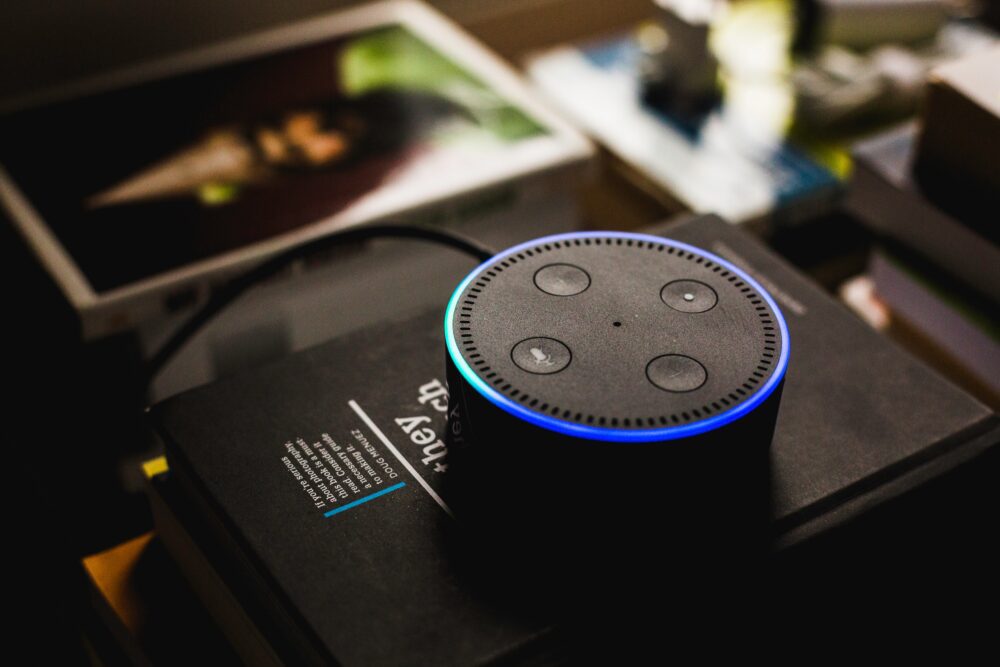Voicetech has quickly gone from a ‘nice to have’ side-project for businesses to being poised to become a legitimate, key channel; both in terms of consumers searching and making purchases.
Smart speakers, the main channel for voice, are, spreading like wildfire. Almost a quarter of UK households already own smart speakers, with more than half of smart device owners using voice commands at least once a day. And these stats are even higher in the US. The growth of these speakers is presenting a fantastic opportunity for commerce – a consensus reached by multiple reports.

By the end of the year, upwards of 20 million Americans will have made a purchase using their smart speaker, and by 2022, it’s predicted that 50% of consumers will use voice shopping, with the market growing to $40 billion in the same timeframe.
Many major retailers are already onboard. Take Tesco and their ‘Talk to Tesco’ skill, which allows you to shop, manage your online basket, and check details about your next delivery in a totally personalised experience. But what’s next? What’s being missed? To consider the potential opportunities, it’s important to first establish why voice is growing like this.
Perhaps most obviously, is because it’s so easy. Using voice is a convenient, hands-free way of multitasking within our increasingly hectic lives. You can cook dinner and order your weekly food shop simultaneously – which would seem like a work of science fiction to people just a decade or so ago.
Our society is constantly pushing for improvement, convenience, and speed when it comes to technology – and this is the next logical step. Reducing the amount of time it takes for our brain to interact with a connected interface is pulling us in like moths to a flame, and voice search goes a long way towards doing that.

It’s also not something that necessarily comes as a surprise. Back in 2016, marketeers everywhere were shouting about an infamous comscore prediction that 50% of all searches would become voice searches by 2020. That sharp rise was hard to imagine at the time, but COVID-19 has undoubtedly played a role in accelerating us towards a position where that may well be true.
The pandemic and subsequent lockdown has led to many people scrutinising their own living spaces, making them as comfortable and life-ready as possible, finally having the time to research, consider, and purchase those new gadgets. Deloitte have claimed that 21.2 million digital devices were purchased during the first two months of the lockdown. And often, smart speakers are at the top of the list. Whether it’s helping with timers, weather reports or playing music, they quickly become an essential part of your home and make you question how you ever did things without them. Not only this, but voice also means you don’t need to physically touch a device, which in our current way of living could be an interesting incentive to use voice more frequently.
So with voice undoubtedly on the rise, what can businesses do to further encourage consumers down this path? What are the opportunities on our doorsteps?
Most importantly, they need to make it simple and feel safe. Brands with basic or generic products will have it the easiest in this space, whereas high-value or niche products will require a bigger consumer behavioural shift if they’re to be purchased via voice.
Perhaps retailers could implement better and more flexible returns policies, or ‘buy now, pay later’ schemes for items they buy via voice? Perhaps consumers browsing online could ‘save’ items which they know they want, and then purchase easily via a simple voice command on payday? Perhaps unique purchase persuasion techniques could help here?
We recently launched the ‘Send me a Voucher’ skill on Amazon Alexa. After saying “Alexa, ask send me a voucher for a JustEat offer”, a unique, working voucher code is then spoken to the user, and sent to them immediately via text or email.
Looking again specifically at the implications of COVID-19, how could voice help reduce the amount of time a customer needs to spend in the store? Or reduce the number of items they come into contact with? An example might be telling a retailer’s voice assistant your size, the kind of garment you’re looking for and your preferred colour or style before entering the store, so that the staff are able to get it ready for arrival. It’s convenient and has the added benefit of being a frictionless experience for customers who might be in a hurry or have already picked out their ideal item online.
Looking slightly further down the line, brands could create enhanced features on their sites that make it easier to purchase via voice, such as supermarkets offering an ‘essentials’ shopping list which can be easily purchased via voice, or even recipe-specific items: “Alexa, order the ingredients for a lasagne from Tesco”. Walmart is already on top of this, having recently partnered with Google to create a voice-powered shopping experience in a bid to compete against Amazon Essentials.
Just as many businesses have digital ‘storefronts’ online where customers are able to view information about them, brands need to start thinking about their voice ‘storefront’. If I ask my smart speaker about what Topman does, I should be able to get Topman’s own description that has been written especially for voice. This is just one way that they can add extra appeal and make a good impression on potential customers. Brands like Nike have made a good start with the technology, with our collaboration Nike Coach offering a personal fitness coach through voice, but the next step should be their entire storefront.
It’s a phrase misused a lot, but I truly believe voice is not just set to become the next big thing – it is the next big thing. With many untapped avenues waiting to be explored, it’s time to get onboard and become a pioneer before you miss the boat.
Rob Bennett, CEO of creative technology agency Rehab
















